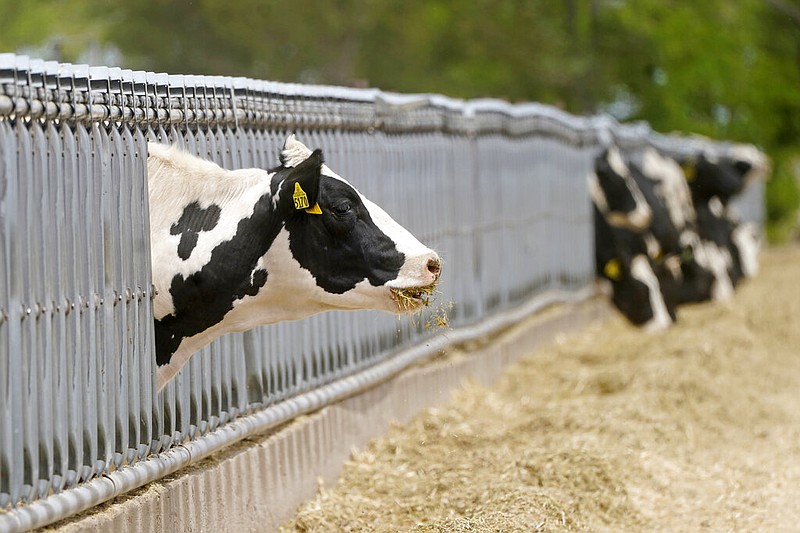Lack of rain this summer and high prices for hay have pressured Arkansas cattle ranchers into selling cattle earlier than usual.
Drought conditions have been reported across the state since June.
The U.S. Drought Monitor currently shows extreme drought in 23 northern counties and four southwest counties, a band of severe drought across western and central Arkansas heading east, as well as moderate drought extending across much of the southern half of the state, as of July 28.
Despite recent rains, every county is experiencing either abnormally dry or drought conditions, which has affected ranchers' ability to keep cows fed and watered.
The USDA's June 22 cattle inventory report found U.S. cattle numbers fell below 100 million, the lowest inventory level since 2015, due to drought across the West.
Drought conditions have also affected the cattle industry in Arkansas, where there has been a 20% increase in cattle sales in Arkansas.
"When we see a decline in cattle inventories like we did in [the USDA] report, it just gives us evidence that we're seeing another year of herd liquidation," University of Arkansas System Division of Agriculture livestock economist James Mitchell said.
The volume of cows being culled and brought to market to be sold this summer is not typical of Arkansas cattle ranchers for this time of year, Mitchell said.
"We would typically see those volumes increase during the fall, so because we're seeing larger volumes of cull cows at this time of year, it's evidence drought is kind of the leading factor contributing to that," Mitchell said.
The United States is entering a phase where cattle prices are expected to improve, Mitchell said.
Cattle inventories have been decreasing since 2019 nationally and in Arkansas, and as supplies get tighter, prices will increase to reflect tighter supplies.
"So the expectation this fall is that we're actually going to see quite strong cattle prices in the state," Mitchell said.
But ranchers having to sell more cows than they expected is not necessarily a good thing.
"When we look at those numbers, we're seeing fewer beef cows; evidence that producers are culling their herds because of things like drought pressure, higher inputs, lower returns potentially," Mitchell said.
Mitchell said inventory estimates were better than expected, but lower beef cow numbers will mean fewer calves will be born and enter the beef production supply chain in the future.
Agriculture experts say it's important now more than ever for ranchers to use sustainable practices to build resiliency and help them handle dry years.
University of Arkansas System Division of Agriculture Animal Science Associate Professor Dirk Philipp said from a grass management standpoint, it's helpful to rotate cattle to give a rest to grasses for grazing; it's about becoming more resilient so ranchers can rebound from drought, he said.
"Farmers probably have to come to terms with the fact climate extremes increase over time and that could mean a three-week drought, which is not atypical for Arkansas in August or September, we have to deal with the situation now where you have no rain for six or eight weeks," Philipp said.
"But you can make your entire system more resilient by diversifying your forage base. You have areas where you have forage growing that can be grazed through the winter time, then you have forage you can use during the summer time and by leaving a good canopy cover on them, that certainly helps in retaining soil water."
Ranchers typically allow their cattle to continuously graze on a pasture, but this can lead to overgrazing, which can result in farmers having to purchase more hay during drought.
Forage, or grass-growing strategies like rotational grazing, can help mitigate overgrazing.
Soil and hay testing are other inexpensive management tools that can be used to get a snapshot of ranchers' soil and hay nutrients so they can choose their best pastures for grazing, which can positively impact their fertilizer costs, Southwest Research and Extension Center Director Daniel Rivera said.
Rivera said ranchers in the Southeast tend to rely on ponds for watering cattle, but he advocates for watering systems and wells instead.
"Situations like this really show how fragile that can be, with our ponds," Rivera said.
Rivera said some ranchers are looking at solar panels to power their wells so they can water their animals and crops and reduce energy demand on their farms.
River Valley cattle rancher Matt Hoien has 250 head of cattle on approximately 700 acres of pasture in Pope County.
Hoien relies on the ponds to water his cattle and does not have any type of irrigation system on his land.
Hoien has implemented a few sustainable practices to prepare for drought.
"The first thing I do is rotating the cattle through the pastures and letting the pastures rest, of course the more grass you can keep on them, the lower the soil temperature, because the sun's not hitting the soil directly, so that holds moisture," Hoien said.
"The idea is, the grass will last longer," he said.
"The only thing is, when you have one inch of rain in seven weeks, even that type of management definitely is not as effective because you just don't get as much regrowth. I certainly think I lasted longer grazing and I still have a little bit left than somebody who just opens the gate and lets them run wherever," Hoien said.

